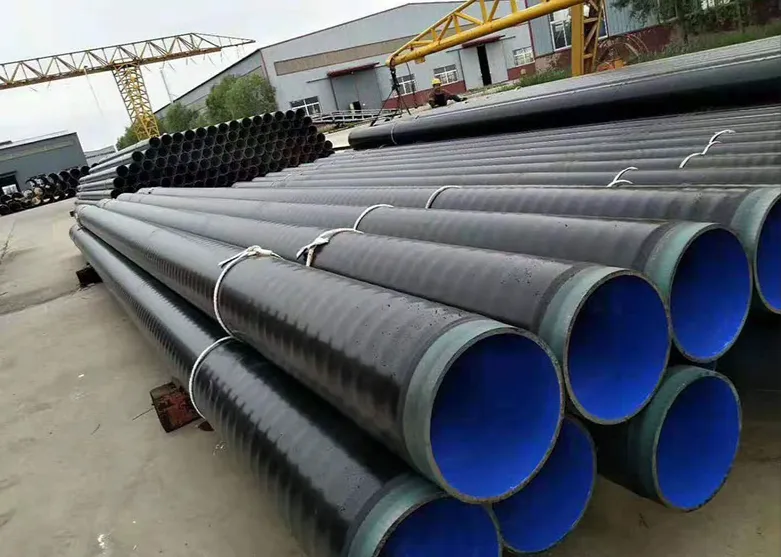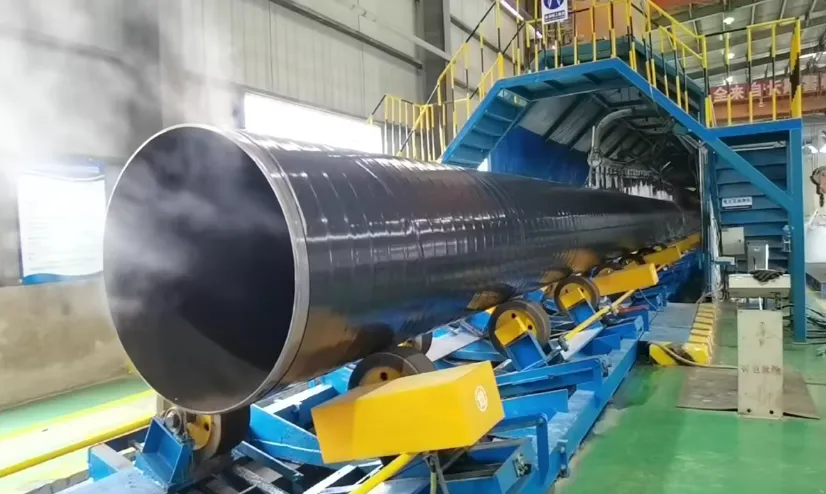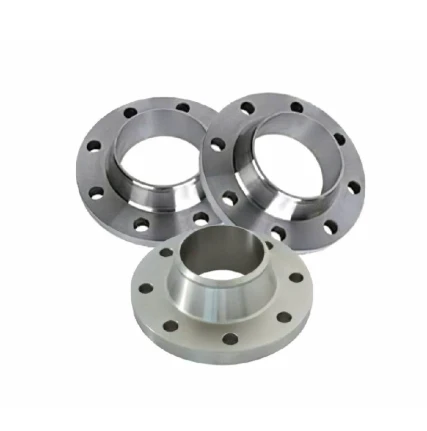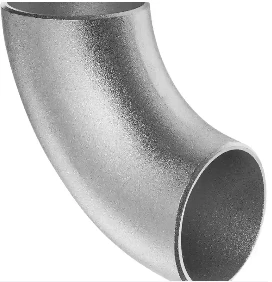1.TPEP steel pipe anti-corrosion process
1. Surface pretreatment
1. Cleaning treatment: First, the surface of the steel pipe should be cleaned to remove oil, grease and other impurities. Usually, organic solvents (such as acetone, trichloroethylene, etc.) are used for cleaning, or alkaline washing is used to remove oil with alkaline solutions such as sodium hydroxide, and then rinsed with clean water.
2. Rust removal treatment: Rust removal is a key step, and sandblasting is often used for rust removal. By spraying high-speed abrasives (such as quartz sand, corundum sand, etc.) onto the surface of the steel pipe, rust, oxide scale, etc. are removed. The rust removal level is generally required to reach Sa2.5 - Sa3 level. Sa2.5 level means very thorough rust removal, and there is no visible grease, dirt, oxide scale, rust and paint coating on the steel surface. Any remaining traces should only be slight spots in the form of dots or stripes; Sa3 level is the most thorough rust removal, and there is no visible grease, dirt, oxide scale, rust and paint coating on the steel surface. The surface should show a uniform metallic color.
2. Epoxy powder coating (FBE)
1. Preheating steel pipe: Before applying epoxy powder, preheat the steel pipe to a certain temperature (usually 200-230℃) to make the epoxy powder melt and adhere to the surface of the steel pipe better.
2. Electrostatic spraying: Electrostatic spraying technology is used to evenly spray epoxy powder onto the inner surface of the preheated steel pipe. The principle of electrostatic spraying is to use a high-voltage electrostatic field to charge the epoxy powder, which is adsorbed to the grounded steel pipe surface under the action of the electric field force.
3. Curing treatment: The sprayed steel pipe enters the curing furnace, and the epoxy powder is cured under a certain temperature (180-200℃) and time (usually 2-3 minutes) to form a hard and dense inner coating. The thickness of the epoxy powder inner coating is generally 300-500μm. It has excellent adhesion, corrosion resistance and chemical resistance, and can effectively prevent the inside of the steel pipe from being corroded by the conveying medium.
3. Adhesive layer coating
1. Coating method: After the epoxy powder inner coating is cured, the adhesive is applied to its surface by extrusion coating. The main function of the adhesive is to enhance the bonding between the inner coating and the outer polyethylene layer.
2. Thickness control: The thickness of the adhesive layer is generally 150-250μm, and its material is usually vinyl copolymer, which can make the inner and outer coatings tightly bonded to prevent stratification between the coatings.
4. Three-layer polyethylene outer coating (3PE)
1. Bottom layer (copolymer adhesive): First, a layer of copolymer adhesive is applied, which works in synergy with the adhesive layer to further enhance the bonding of the inner and outer coatings. This layer is extruded through an extruder and attached to the adhesive layer, with a thickness of about 150-250μm.
2. Middle layer (high-density polyethylene): The middle layer is the main anti-corrosion and protective layer, using high-density polyethylene (HDPE). It is coated on the bottom adhesive by extrusion molding, and the thickness is generally 2-2.5mm. High-density polyethylene has good corrosion resistance, impact resistance and aging resistance, and can resist corrosion from the external environment, such as soil corrosion, water erosion and ultraviolet radiation.
3. Outer layer (polyethylene): The outermost layer of polyethylene mainly plays a protective role, and the material can be medium-density or low-density polyethylene. The outermost layer of the steel pipe is formed by extrusion coating, with a thickness of about 1-2mm. It can prevent the middle layer from being mechanically damaged and also has certain weather resistance.
2. Uses of TPEP steel pipes
1. Oil and gas transportation
1. Long-distance transportation pipelines: TPEP steel pipes are widely used in long-distance transportation of oil and natural gas. Its excellent anti-corrosion performance can effectively prevent the pipeline from being corroded in underground or submarine environments, ensuring that oil and natural gas can be safely and stably transported from the mining site to the refinery or storage facility. For example, in cross-border oil and gas pipeline projects, TPEP steel pipes can resist corrosion under different geological conditions (such as saline-alkali land, wet soil, etc.) and climatic conditions (such as high temperature, severe cold, etc.), reducing the risk of pipeline leakage.
2. Urban gas distribution pipeline: In the urban gas distribution network, TPEP steel pipe also plays an important role. It can prevent the corrosion of chemical substances (such as hydrogen sulfide, etc.) in the gas to the pipeline, and can withstand the complex environmental conditions of the city underground, such as groundwater immersion, soil pressure, etc. Moreover, its good sealing performance helps to ensure the safety of gas transportation and prevent gas leakage from causing safety accidents.
2. Chemical industry pipeline system
1. Corrosive medium transportation: In the chemical production process, various corrosive chemical media such as acid, alkali, and salt solution need to be transported. The multi-layer anti-corrosion structure of TPEP steel pipe can effectively resist the erosion of these corrosive media. For example, in the acid and alkali transportation pipeline of a chemical plant, TPEP steel pipe can operate stably for a long time, reduce the frequency of pipeline maintenance and replacement, and thus reduce production costs.
2. Transportation of chemical raw materials and products: For the transportation of chemical raw materials and products, TPEP steel pipe can ensure the safety and quality of the transportation process. Whether it is liquid chemical products (such as various organic chemicals) or gaseous chemical raw materials (such as ethylene, propylene, etc.), TPEP steel pipes can provide reliable transportation channels to prevent product contamination or loss caused by pipeline corrosion.
3. Water conservancy projects and water supply and drainage systems
1. Drinking water delivery pipelines: In water supply and drainage systems, TPEP steel pipes can be used for drinking water delivery. Its anti-corrosion performance can ensure the quality of drinking water, prevent metal ions in the pipeline from dissolving into the water, and also resist the corrosion of microorganisms and chemicals in the water to the pipeline.
2. Sewage treatment pipelines: For sewage treatment pipelines, TPEP steel pipes can resist the erosion of various corrosive components in sewage (such as sulfides, organic matter, etc.). Moreover, during the sewage transportation process, the pipeline may be subject to certain pressure and scouring, and the high strength and wear resistance of TPEP steel pipes can also meet the use requirements.
-
Cangzhou Yulong Steel Co., Ltd.
-
Mugikorra:
+86 13303177267 -
Posta elektronikoa:
admin@ylsteelfittings.com
- ingelesa
- arabiera
- italiarra
- gaztelania
- portugesa
- alemana
- kazakh
- pertsiera
- grekoa
- frantsesa
- errusiera
- poloniarra
- thailandiera
- Indonesian
- Vietnamera
- Zulua
- Korean
- uzbekera
- Ezetz
- serbiarra
- malaysiera
- Ukrainara
- gujaratera
- Haitiko kreolera
- hausa
- hawaiarra
- hebreera
- Miao
- hungariera
- islandiera
- igbo
- irlandera
- japoniarra
- Javanera
- Kannada
- Khmer
- Ruanda
- afrikarra
- Albaniarra
- Amharikoa
- armeniarra
- Azerbaijangoa
- euskara
- bielorrusiera
- bengalera
- bosniarra
- bulgariera
- katalana
- Cebuano
- Txina
- Txina (Taiwan)
- Korsikera
- kroaziera
- Txekiar
- Danimarka
- esperantoa
- Estoniarra
- Finlandiera
- frisiera
- galegoa
- georgiarra
- kurduera
- kirgizera
- TB
- latina
- letoniera
- Lituaniera
- Luxenburgera
- Mazedoniera
- Malgashi
- malayalamera
- maltera
- maoria
- Marathia
- Mongoliera
- Myanmar
- Nepaliarra
- Norvegiara
- Norvegiara
- okzitaniera
- Paxtuera
- holandarra
- punjabera
- errumaniera
- samoarra
- Eskoziako gaelikoa
- ingelesa
- Shona
- Sindhia
- Sinhalera
- eslovakiera
- Esloveniera
- somaliera
- Sundanera
- Swahilia
- Suediera
- Tagalog
- Tajik
- Tamila
- tatariarra
- Telugu
- turkiera
- Turkmenera
- Urdu
- uigurrera
- galesera
- Laguntza
- Jiddisha
- Yoruba

Idatzi zure mezua hemen eta bidali iezaguzu
Related News
-
Apr . 29, 2025What Are ANSI B16.5 Welding Neck Flanges?In the intricate world of industrial piping, where precision and reliability are non-negotiable, ANSI B16.5 welding neck flanges stand as a testament to engineering excellence.
-
Apr . 29, 2025Long Radius vs. Short Radius Butt Weld Elbows: How to Choose the Right TypeIn industrial piping systems, the selection of butt weld elbows plays a critical role in ensuring efficient fluid flow, minimizing pressure drop, and maintaining structural integrity.














